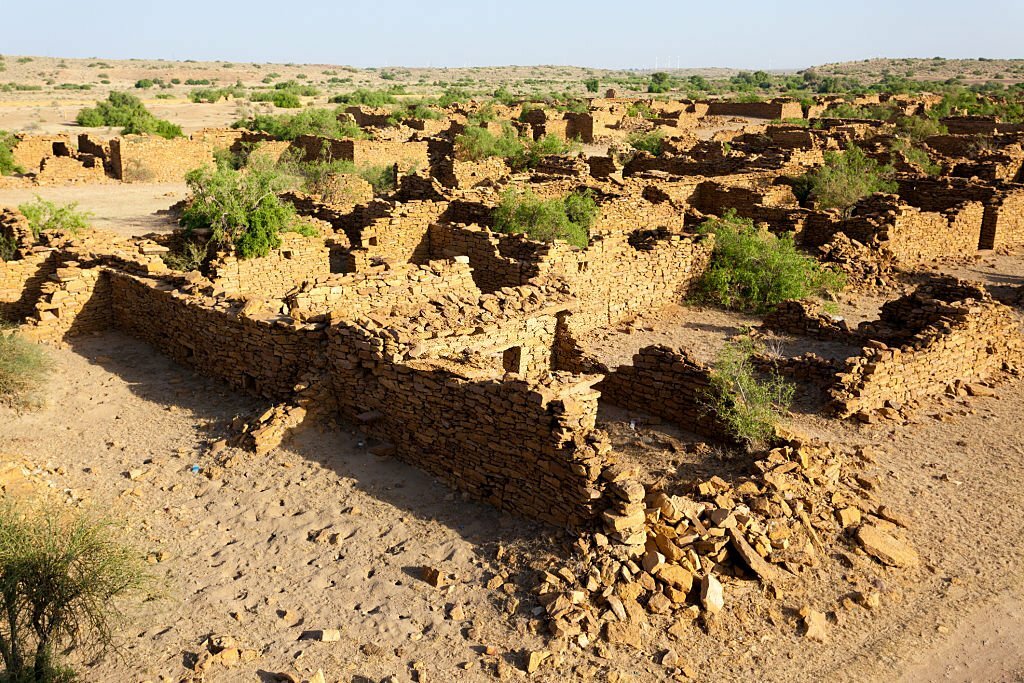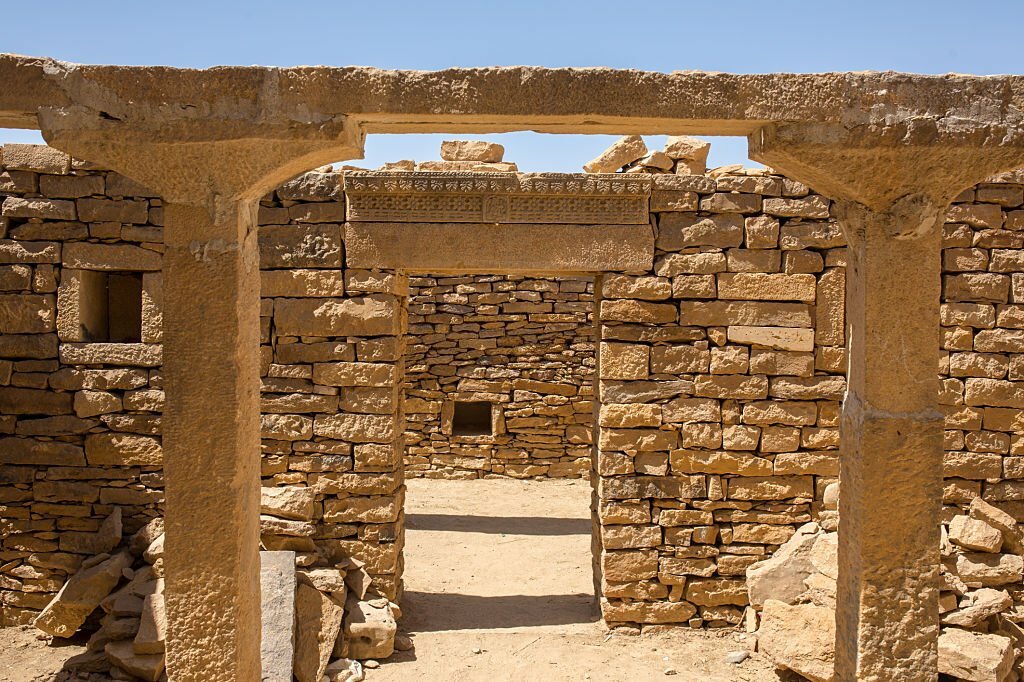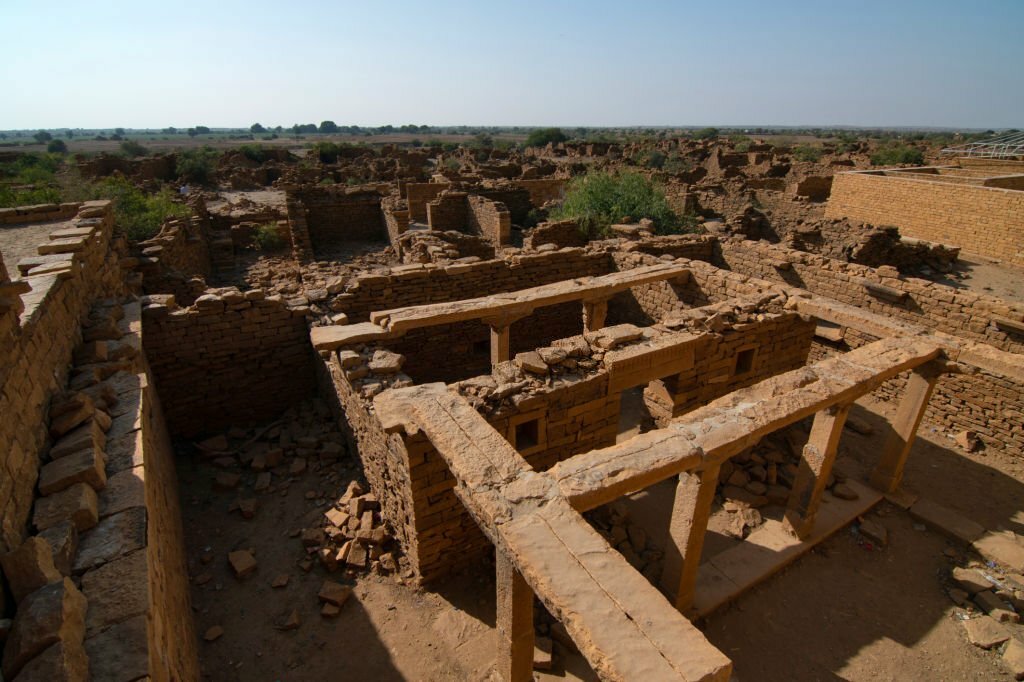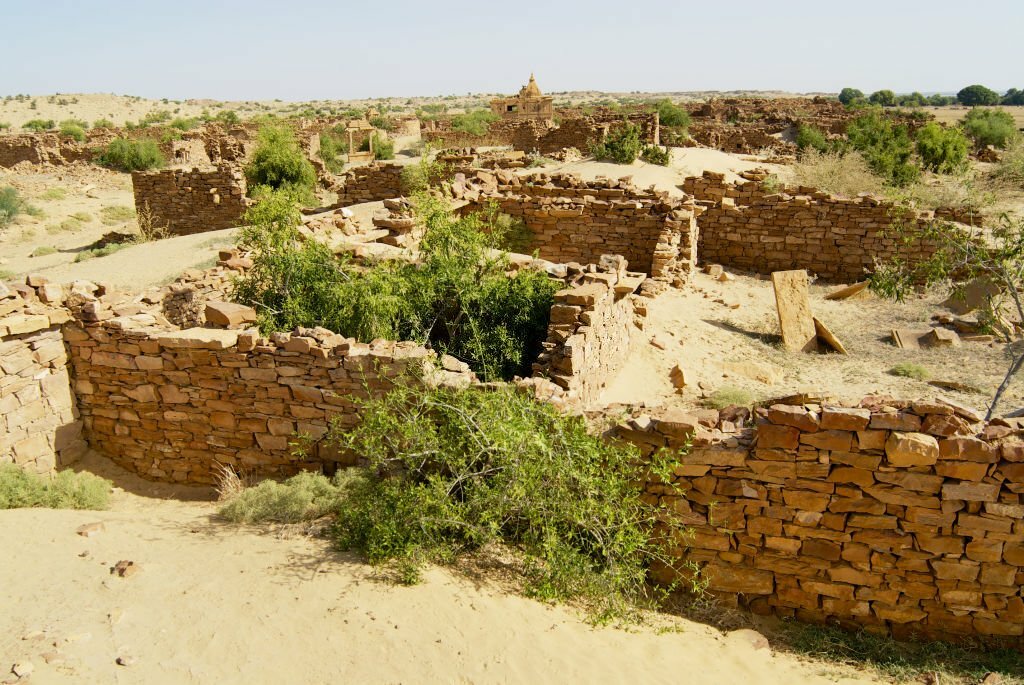The Ghostly Stories of Kuldhara Village: Unsolving The Desert Mysteries
Amongst the many mysteries that Rajasthan holds in its forts and palaces, lies the abandoned Kuldhara village – the ghost village in Rajasthan. Yes! You heard it right not just one palace or haveli, but a whole ghost village which you can get a chance to explore with our Rajasthan Tour Packages.
Nestled in the heart of Rajasthan, India, in the vast expanse of the Thar Desert stands one of the most haunted places in Rajasthan – the Kuldhara village. Abandoned centuries ago, its shattered structures tell tales of a once-thriving community. The reasons behind its sudden abandonment remain a puzzle, adding to the mystique that surrounds this ghostly village.
In this blog, let’s delve deeper into the Kuldhara Village history which is full of mysteries and eerie stories and what makes this place one of the top tourist attractions in Rajasthan.
Location And Geography Of The Kuldhara Village

Kuldhara Village is located about 18 km southwest of Jaisalmer, Rajasthan. It is a rectangular village measuring 861 m x 261 m and is oriented north-south. The main feature of the Kuldhara village is the temple dedicated to the mother goddess. This temple serves as the center of this once-prosperous village. The layout of the village consists of 3 main longitudinal roads which are intersected by many narrow lanes like a maze.
A city wall still stands, marking the site’s northern and southern limits. On the eastern side, the site faces the dried-up Kakni river bed, while on the western side, the back walls of human-built structures provide protection.
This geographical layout, combined with the village’s archaeological remains, provides visitors with an insight into the history and architecture of the site and invites them to uncover the secrets hidden within its mysterious ruins.
Other Unique Villages in India: Kongthong Whistling Village: A Musical Journey In Meghalaya
Kuldhara Village Story

The history of Kuldhara village is steeped in uncertainty. Local legends speak of an oppressive ruler and the villagers’ collective decision to leave, cursing the land as they departed. Theories abound, but the truth remains a mystery, buried beneath layers of time. Here are some versions of the Kuldhara Village story that are popular local legends:
Local Legend: Salim Ali’s Forbidden Love
In the heart of Kuldhara Village, a cursed love story unfolds, echoing through time like the whispers of the desert wind. In the 19th century, the Kuldhara Village was a prosperous settlement of the Paliwal Brahmins, who had migrated from Pali to settle here.
According to the legend, Salim Ali the then-prime minister of Jaisalmer was attracted to the village head’s daughter and wanted to marry her by force. He threatened the villagers with dreadful consequences if the marriage didn’t happen. The entire village unanimously opposed the marriage and took a decision that changed the faith of the Kuldhara village.
To protect their families and the village head’s daughter from the cruelty of Salim Ali, the villagers decided to leave the village. But, before leaving the village they cast a curse upon the Kuldhara Village that it would be never inhabited again.
After this curse, the Kuldhara village remained inhabited as no one could ever settle in this village and those who tried fled the next day as they feared the paranormal activities they experienced.
Alternative Version: Taxes By Salim Ali
In a more believable twist of the Kuldhara Village story, there is another legend associated with the cruel ruler Salim Ali. He raised the taxes which was a heavy burden to the villagers, given the harsh conditions of the desert. It was not possible for the villagers to survive with such heavy taxes under their cruel and greedy ruler. The burden of taxes and harsh natural conditions made the villagers migrate out of Kuldhara Village in search of a better life.
Other Calamities and Mysteries
The isolation of the Kuldhara Village is not only limited to human tragedies. The Kuldhara village faced several natural calamities, mainly a lack of water. The arid landscape of the desert made the conditions very dry and inhabitable. This forced the villagers to seek shelter in other places.
Some scientists also claim that the Kuldhara village was abandoned due to an earthquake forcing the villagers to relocate. The destruction of the Kuldhara village houses also suggests the same. However, this theory was discarded since no dead bodies were found in the entire Kuldhara Village during excavations.
The Answered Questions about the Vanishing Villagers
Given into consideration of all the above versions of the Kuldhara Village Story, there is one thing that still remains a mystery. If you take a walk around the abandoned village, you will find a specific pattern in the damaged houses. Most of the walls are damaged diagonally and the houses have no roofs at all, and this symmetrical destruction clearly discards the earthquake theory.
Another question arises as to who damaged all the houses in this village. The amount of time passed and the erosions that occur with time have a huge gap. No one knows how these houses were damaged to such an extent!
The mystery deepens with the vanishing of the villagers. No one could trace where the villagers settled after abandoning the Kuldhara Village. They just vanished from the face of the earth overnight. The mysterious ruins of Kuldhara, with their distinct signature of destruction, serve as mysterious monuments to a past hidden within the mysteries of the desert’s sands.
Other Unique Villages in India: World’s Only No-Door Village – Shani Shingnapur Travel Guide
The Kuldhara Village History

The Kuldhara Village history dates back to the 13th century when this village was established. It was once a thriving place for the Paliwal Brahmins, who are known for their creative minds. In terms of style, the men wore Mughal-style turbans or jamas, complemented by kamarbands, beards, necklaces, and khanjars. Women graced themselves in tunics or lehengas, often adorned with necklaces.
According to the Kuldhara Village history, the villagers thrived as agricultural traders, bankers, and farmers. Their skillful use of ornamented pottery crafted from fine clay reflected both utility and artistic expression. Water, a precious resource in the arid landscape, was sourced from the Kakni River and various wells. The ingenious use of khareens, artificial depressions dammed on three sides, facilitated agriculture even in the challenging desert terrain.
Kuldhara’s architectural marvels stand as a testament to the Paliwals’ brilliance. Their homes, constructed considering geographical and scientific factors, boasted efficient ventilation, maintaining a pleasant temperature amidst scorching heat. The village showcased private wells and stairs, highlighting the community’s intelligent urban planning.
The Kuldhara village history is a witness of transforming the barren landscape into a prosperous village by the Paliwal Brahmins, earning renown for their agricultural prowess and water management skills. Today, Kuldhara’s silent ruins echo the vibrant history of a community that once thrived against the odds of the desert.
Other Unique Villages in India: The Story Of Kodinhi Village, Kerala: The Land Of 400+ Twins
Tourism in Kuldhara Village

As you step into the ancient embrace of Kuldhara Village History, a sandstone gate welcomes you, a testament to a bygone era. In the silence, an older local, a guardian of the abandoned town, might share tales at the entrance. Once veiled in mystery, this village now stands as a heritage site, actively developed by the Rajasthan government since 2015.
Maintained by the Archaeological Survey of India (ASI), Kuldhara village has undergone significant renovation. A little temple, nestled amidst houses, stands renewed, its walls echoing the glow of long-extinguished lamps. The village, frozen in time for two centuries, unfolds as a patchwork of open houses, ruins, and a sense of despair.
Visitors describe Kuldhara village as a ghostly haven, with scarce vegetation and dilapidated houses. A few buildings and the temple offer glimpses into the village’s history. A haunting unease hangs in the air, fueled by ghostly sightings and unexplained sounds, inviting explorers into the enigma.
Abandoned since its curse-laden departure, Kuldhara Village remains uninhabited, captivating those drawn to the paranormal. The village, a canvas for Bollywood films like ‘Agent Vinod,’ attracts tourists from 8 AM. to 6 PM.
Today, this ghost village in Rajasthan-Kuldhara invites you to unravel its mysteries, walk its dusty pathways, and ponder the architectural feat of the Paliwal Brahmins amidst the tranquil embrace of the Thar Desert. Visiting Kuldhara is not just a journey into the past but an immersion into the mystique that still lingers in the silent corridors of this abandoned village.
Other Unique Villages in India: Jatinga Village Bird Suicide Mystery: Unsolving Bermuda Triangle Of Birds
Frequently Asked Questions About the Kuldhara Village
Where is Kuldhara Village located, and what makes it unique?
Kuldhara Village is nestled in the Thar Desert, Rajasthan, just 17-20 kms from Jaisalmer, India. What sets this village apart is the Kuldhara Village history, known for the sudden and unexplained abandonment by the Paliwal Brahmins in the early 19th century. The village is renowned for its haunting mysteries, making it a unique destination for those intrigued by the paranormal.
Can visitors explore Kuldhara Village, and what attractions does it offer?
Kuldhara’s ghost town is open to visitors who want to discover its mysterious secrets. The ghost town, which is managed by the Archaeological Survey of INDIA (ASI), has a sandstone gate and a well-preserved temple, as well as a patchwork of decaying houses that have been frozen in time.
Is there a fee to visit Kuldhara Village?
Yes, the entry fee to explore the Kuldhara Village is ₹10 per person. If you want to take your car inside the village to explore, then you will have to pay an additional cost which is ₹50.
What are the best times to visit Kuldhara Village?
The best time to visit the Kuldhara village is during the cooler months, from October to March, when the desert heat is more bearable. The mild temperatures make exploring the ruins and absorbing the village’s history more enjoyable.





